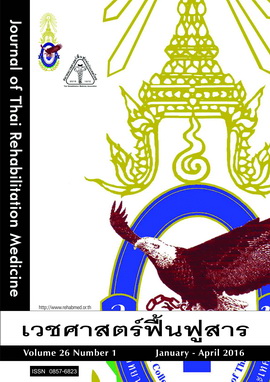การศึกษาระบาดวิทยาในผู้ป่วยเด็ก ที่มารับการรักษาที่ภาควิชา เวชศาสตร์ฟื้นฟู คณะแพทยศาสตร์ศิริราชพยาบาล
การศึกษาระบาดวิทยาในผู้ป่วยเด็ก ที่มารับการรักษาที่ภาควิชา เวชศาสตร์ฟื้นฟู คณะแพทยศาสตร์ศิริราชพยาบาล
Keywords:
epidemiology, pediatric rehabilitation, cerebral palsyAbstract
Objectives: To study the epidemiology of new pediatric patients of the year 2001 at Department of Rehabilitation Medicine, Siriraj Hospital.
Study design: Descriptive study
Setting: Siriraj Hospital
Subjects: New pediatric outpatients attending the rehabilitation out-patient clinic for the first time in 2001.
Methods: Retrospective study of new pediatric patients from outpatient clinic record of Department of Rehabilitation Medicine, Siriraj Hospital between January 1st to December 31st, 2011
Results: There were 443 new patients, 54.9% were males and 49.4% aged between 0-4 years old. The most common problem was neurological disorder (25.8%) with mainly cerebral palsy (CP) followed by congenital anomalies or genetic diseases (23.7%) and musculoskeletal disorders (23.7%). Among CP patients, spastic quadriplegia was the most common type and contracture was the main complication (64.7%). Scoliosis was the most commonly found between 10-14 years old. Most traumatic patients suffered from burns (45.4%) and 50% developed contractures. Only 5.6% of pediatric patients were received IQ evaluation. History of education and caregiver were recorded less than 20%.
Conclusion: The survey of new patients attending the pediatric rehabilitation outpatients at Siriraj Hospital in the year 2011 found that the most common age group was 0-4 years old and the most common problems of neurological condition followed by congenital anomalies and genetic diseases and musculoskeletal problems. Joint contractures are the most common complications.
References
2. Nelson KB, Ellenberg JH. Epidemiology of cerebral palsy. Adv Neurol. 1978;19:421-35.
3. Pongurgsorn C, Tosayanonda O. Clinical study in cerebral palsy. J Thai Rehabil. 1992;2:14-9.
4. Chavasiri S. Prevalence of Malnutrition in Cerebral Palsy at department of Rehabilitation Medicine, Siriraj Hospital. J Thai Rehabil Med. 2014;24:55-9.
5. Douglas ES, Clare MB, Felix OM, Janet MR, Nicholas JS. Childhood disability and socio-economic circumstances in low an d middle income countries: systematic review. BMC Pediatrics. 2011;11:119.
6. Liu SL, Huang DS. Scoliosis in China. A general review. Clin Orthop Relat Res. 1996; 323:113-8.
7. Huang NQ, Guo HS, Liu J, Huang GX, Yang XH, Chen J, et al. A survey on adolescent scoliosis in Guangzhou. Zhonghua Liu Xing Bing Xue Za Zhi .2011;321:38-41.
8. Burch C, Hudson P, Reder R, Ritchey M, Strenk M, Woosley M. Cincinnati Children’s Hospital Medical Center: Evidence- based clinical care guideline for Therapy Management of Congenital Muscular Torticollis, http://www.cincinnatichildrens. org/svc/alpha/h/health- policy/ev-based/otpt.htm, Guideline 33, pages 1-13, 11-19-09.
9. Ballock RT, Song KM. The prevalence of nonmuscular causes of torticollis in children. J Pediatr Orthop. 1996; 16:500-4.
10. Tosayanon O. Cerebral palsy, Rehabilitation academic conference 23rd , Faculty of medicine Siriraj hospital, Mahidol university 1981; 82.
11. Ester G, Helen D, Inge KM, Susanne HR, Christine C, SCPE Collaborative Group. Cerebral palsy and congenital malformations. Euro J Paediatr Neurol Soc. 2008;12:82-8.
12. Palisano R, Rosenbaum P, Walter S, Russell D, Wood E, Galuppi B. Development and reliability of a system to classify gross motor function in children with cerebral palsy. Dev Med Child Neurol. 1997;39:214-23.
13. Palisano RJ, Rosenbaum P, Bartlett D, Livingston MH. Content validity of the expanded and revised Gross Motor Function Classification System. Dev Med Child Neurol. 2008;50: 744-50.
14. Terjesen T. The natural history of hip development in cerebral palsy. Dev Med Child Neurol 2012; 54(10): 951-7.
15. Lai DC, Tseng YC, Guo HR. Trends in the prevalence of childhood disability: Analysis of data from the national disability registry of Taiwan, 2000-2011. Res Dev Disabil. 2013;34:3766-72.
16. Matson JL, Kozlowski AM. The increasing prevalence of autism spectrum disorders. Research In Autism Spectrum Disorders. 2011;5:418-425.
17. Rutter M. Incidence of autism spectrum disorders: changes over time and their meaning. Acta Paediatr 2005;94:2-15.
18. Wing L, Potter D. The epidemiology of autistic spectrum disorders: is the prevalence rising? Ment Retard Dev Disabil Res Rev. 2002;8:151-61






